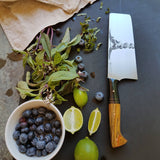
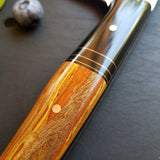
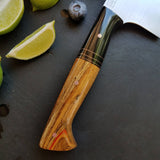
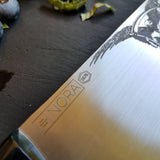
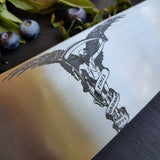
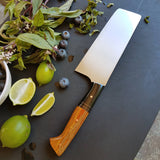
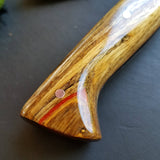
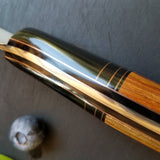
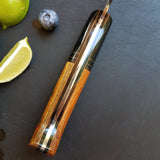
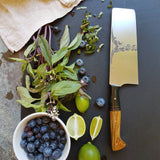
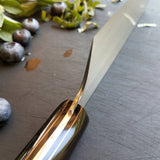
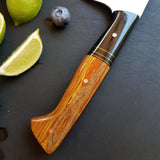
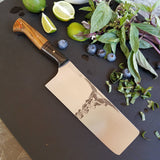
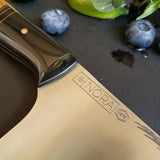
NORA #1676 - 6.5 Inch Nakiri - AEB-L Stainless Steel - Finis Coronat Opus (the end crowns the work)
$ 479.71
KNIFE HIGHLIGHTS
- Blade Type: Nakiri
- Blade Length: 6.5 Inches
- Total Length: 11.75 Inches
- Handle Style: Western | Right or Left Hand Use
- Steel: AEB-L Stainless Steel
- Handle Materials: Black G10, Copper, Black G10 liners, "Seismic" wood base
- Rockwell Hardness: 61 HRC
- Grind Type: Full Flat
- This Blade is Ground...
- Thin for Performance (best performance but delicate! No bones, no frozen food, hard squashes, etc. )
- Thick for Durability (tough, built to last for heavy wear-n-tear)
- >>> Mid-Range with Special Geometry (specially ground for food release and glide but blade is kept slightly thicker for durability)
- This Knife Feels...
- >>>Heavy in Hand (hefty, durable)
- Light (nimble, maneuverable)
- Not too heavy, not too light (Switzerland)
GENERAL USES OF THIS KNIFE:
NAKIRI
The Nakiri knife is a Japanese style knife that is specifically designed to excel at cutting and prepping vegetables and greens. These blades are very thin and literally fall through food. Because of the thinness, these blades should not be used for cutting through any type of bone or harder objects but you would be surprised at the versatility of the Nakiri. We find we use ours for a wide array of tasks in the kitchen - everything from protein prep to bread.
The blade height is just over 2 inches which is larger than many other Nakiri's but we find it helps keep your knuckles off the board and it works well with many larger vegetables.
ENGRAVING:
This engraving is taken from a vintage 1892 copy of The English Illustrated magazine. The image features father time holding a scythe and hourglass. The wording is Latin and reads: Finis Coronat Opus. This translates into English as: "The end crowns the work."
I think this phrase can be understood in a number of different ways but for us, its a reminder that you can't win a race that you don't finish. We are THE WORST at starting projects that we don't finish so maybe your like us and just need a gentle reminder to nudge you forward. (Or not so gentle...Sir Time seems a bit solemn) If so, then this is your knife.
General Notes: This knife has been custom engraved. The engraving was done via fiber laser so there is depth to the engraving more so than you generally see with an electro etch or CO2 laser. We do, however, keep the depth low so it does not catch food and minimally interferes with the primary cutting function of the knife. A small amount of stickage is normal around the engraved area, especially initially. (due to a very small burr that is formed around the engraved area) This will lessen over time as the blade is used. The engraving should last as long as the knife but please note that it will slightly degrade over time as abrasives are used on the knife. We recommend the soft end of a sponge with soap and water for cleaning and mineral oil periodically to condition the blade (and handle). Keep in mind that stronger abrasives, such as steel wool, scotch brite pads, sand paper or stone sharpening directly on the engraved image will further degrade the image.
HANDLE DESIGN & MATERIALS:
Every one of our knives is handmade, unique and numbered. This NORA knife has been handled with an elegant combination of black G10, copper striping and a newer material that we just started working with called "seismic" wood. Seismic Wood is made from various kinds of recycled wood. Scales have been heat compressed, vacuum sealed, and stabilized with epoxy resin. The result is an uber durable material and each one is entirely unique based on what has been recycled.
STEEL INFORMATION:
AEB-L STAINLESS STEEL
This knife blade is composed of AEB-L stainless steel which is a high-quality Swedish metal, originally developed for razor blades. Recently, steel suppliers have made this steel available in thicker sheets and it has proven to be an excellent adaptation for the cutlery industry.
AEB-L has a beautiful balance of carbon and chromium and, with proper heat treatment, this steel produces both a very fine edge as well as excellent toughness and edge stability. The fine grain structure also makes this steel very easy to sharpen. We believe it is one of the finest stainless steels available on the market today for use with kitchen knives.
As a side note, there are two things we like to mention about this steel:
1.) This steel responds beautifully to honing and if the knife is honed regularly it should need infrequent sharpening.
2.) AEB-L is a stainless steel but just barely. The higher carbon content in this stainless is what allows it to get a fine edge and higher hardness than other stainless steels but it also has a tendency to sometimes form very fine rust spots on the blade. If this happens, these are easily removed with a green scotch brite pad and usually the rough end of a kitchen sponge will also do the trick.
